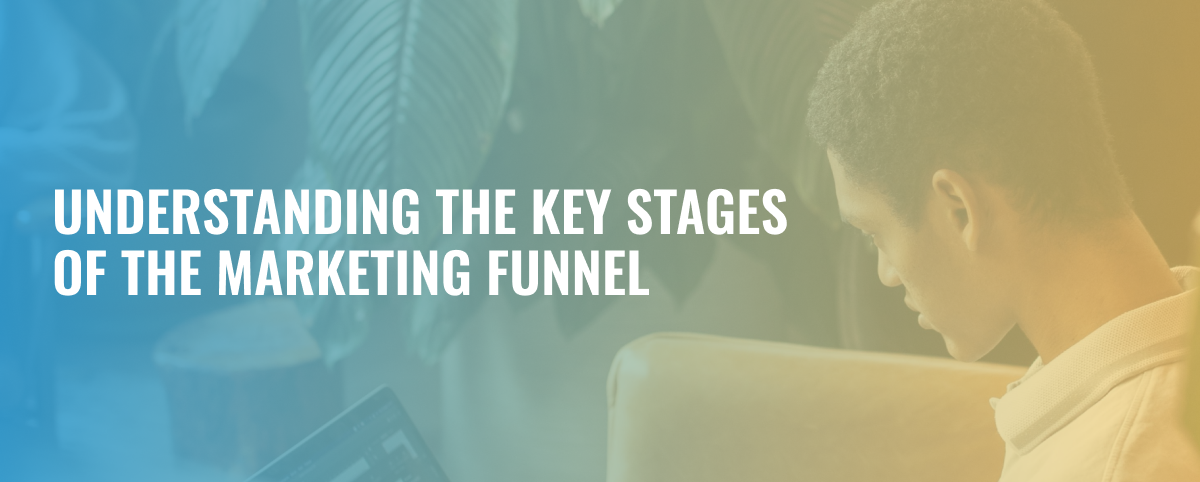8 minute read
Understanding the Key Stages of the Marketing Funnel
The marketing funnel is a fundamental concept in any successful marketing strategy. It describes the key stages a consumer goes through before making a purchasing decision. Understanding the different stages of the marketing funnel is essential for businesses to effectively attract and convert leads. The marketing funnel serves as a roadmap for businesses to effectively target potential customers and convert them into loyal, paying customers.
WHAT IS A MARKETING FUNNEL?
A marketing funnel is a strategic approach used by companies to better understand and analyze customer behavior and guide them through the purchasing process. It is a visualization of the customer journey, from the first encounter with a product or service to the final purchase decision. The purpose of a marketing funnel is to attract potential customers through various channels, educate them about your product or service, and ultimately convince them to take action. By breaking down the customer journey into different stages, companies can tailor their marketing efforts and create a more effective and targeted approach to increasing sales and revenue.
WHAT DOES A MARKETING FUNNEL LOOK LIKE?
-
AWARENESS
The first stage of the marketing funnel is awareness. This is the moment when a potential customer becomes aware of your brand, product, or service. It involves building brand awareness through various marketing efforts such as social media advertising, influencer marketing, and content marketing. In this phase, the goal is to attract a large audience and get them interested in your brand.
-
INTEREST
The next stage of the marketing funnel is interest. This is when potential customers who heard about your brand in the previous phase show interest in learning more about your products or services. In this phase, companies must provide valuable information to potential customers to keep them interested and move on to the next phase.
-
CONSIDERATION
Consideration is the third stage of the marketing funnel. At this point, potential customers have shown great interest in your brand and are actively considering making a purchase. It’s essential to build trust and position your brand as the best solution for their needs. This can be achieved through email marketing, webinars, and product demos.
-
INTENT
The fourth stage of the marketing funnel is intent. This is the moment when potential customers have made a decision and are ready to make a purchase. At this stage, companies need to make the purchasing process as simple and painless as possible to encourage customers to take action.
-
BUY
The final stage of the marketing funnel is when the prospect becomes a paying customer. At this point, the goal is to provide an exceptional customer experience and strengthen their trust in the brand, which will result in repeat purchases and brand advocacy.
STAGES OF A SALES FUNNEL
-
TOP OF THE FUNNEL
Top of the funnel is the first stage where leads enter the funnel. This is where companies use various marketing techniques such as social media, SEO, and content marketing to attract a large group of potential customers. The goal is to build brand awareness and arouse interest in its products or services.
-
MIDDLE OF THE FUNNEL
Once leads enter the funnel, the focus shifts to converting more qualified leads. During this stage, companies use email marketing, webinars, and lead magnets to connect with potential customers and inform them about their offerings. This helps build trust and credibility and encourages prospects to move further down the funnel.
-
BOTTOM OF THE FUNNEL
At the bottom of the funnel, potential customers are ready to make a purchase decision. Companies use tactics such as discount offers, free trials, and personalized messages to convince potential customers to become paying customers. This is also the stage where companies measure conversion rates and make adjustments to improve the sales funnel.
STAGES OF A SALES FUNNEL
-
TOP OF THE FUNNEL
Top of the funnel is the first stage where leads enter the funnel. This is where companies use various marketing techniques such as social media, SEO, and content marketing to attract a large group of potential customers. The goal is to build brand awareness and arouse interest in its products or services.
-
MIDDLE OF THE FUNNEL
Once leads enter the funnel, the focus shifts to converting more qualified leads. During this stage, companies use email marketing, webinars, and lead magnets to connect with potential customers and inform them about their offerings. This helps build trust and credibility and encourages prospects to move further down the funnel.
-
BOTTOM OF THE FUNNEL
At the bottom of the funnel, potential customers are ready to make a purchase decision. Companies use tactics such as discount offers, free trials, and personalized messages to convince potential customers to become paying customers. This is also the stage where companies measure conversion rates and make adjustments to improve the sales funnel.
5 EFFECTIVE SALES FUNNEL EXAMPLES WITH MAXIMUM CONVERSIONS
-
NETFLIX
Netflix has undoubtedly revolutionized the world of entertainment. In Netflix’s sales funnel, they focus on creating engaging and relevant content that appeals to a wide audience. They use personalized and targeted marketing campaigns on various platforms, such as social networks and search engines, to reach potential customers. Their use of catchy and relatable titles along with attractive images like teasers and thumbnails grabs their audience’s attention and creates awareness about their content.
-
GROUPON
Groupon, a popular online marketplace for daily deals and discounts, has successfully mastered the interest phase in its sales funnel. They have a simple and easy-to-use platform where customers can search for deals and make purchases. In the interest phase, Groupon uses incentives like discounts, limited-time offers, and referral programs to attract potential customers and keep them interested.
-
BASECAMP
Basecamp, a project management tool, has a great decision stage in its sales funnel. They offer free trials to potential customers so they can try out their product before making a purchasing decision. Basecamp also provides detailed and informative content, including case studies, customer reviews, and tutorials, to help customers make informed decisions. Your sales team also interacts with potential customers, answering any questions and addressing concerns, resulting in a higher conversion rate.
-
ZENDESK
Zendesk, a customer service software company, has a perfect promotion stage in their sales funnel. They provide an easy-to-use platform for customers to sign up for their services, making the process quick and easy. They also offer multiple payment options, including credit cards and PayPal, so customers can complete their purchase conveniently.
-
MIXERGY
Mixergy, an online platform for entrepreneurs and business owners, focuses on customer retention in your sales funnel. They offer a membership program that provides access to exclusive content, webinars, and interviews. They also personalize their email marketing and offer discounts and special offers to build customer loyalty.
HOW TO IMPLEMENT THESE FUNNELS INTO YOUR BUSINESS’S MARKETING STRATEGY
-
STUDY YOUR AUDIENCE
The first step to implementing a successful marketing funnel is to study your audience. This means understanding who your target audience is, what their demographics are, and what their behavior is. By knowing your target audience, you can tailor your marketing efforts to appeal to them specifically. This can include creating personalized content, using targeted advertising, and creating a strong brand voice that resonates with your audience. Studying your audience can also help you identify their pain points and needs, which can help you create content and offers that address these specific problems.
-
GRAB THEIR ATTENTION AND OFFER VALUE
Once you have a clear understanding of your audience, the next step is to capture their attention and provide value. This can be achieved in several ways, such as creating eye-catching ads, using attractive images, and offering valuable content. The goal is to pique their interest and make them want to learn more about your products or services. By providing value, you build trust and credibility with your audience, making them more likely to consider your company as a solution to their needs.
-
NURTURE YOUR LEADS
Once you’ve captured your target audience’s attention and provided them with value, the final stage of the marketing funnel is to nurture your lead. This includes building a relationship with your potential customers through lead nurturing techniques such as email marketing, retargeting ads, and social media engagement. The key is to keep your business top of mind and continue to provide value to your potential customers until they are ready to make a purchase. Nurturing your leads increases your chances of converting them into paying customers and building long-term relationships with them.
FAQS
-
WHAT IS THE DIFFERENCE BETWEEN A B2B AND B2C MARKETING FUNNEL?
The marketing funnel is a key concept in understanding the customer journey and behavior. It is a process used by companies to generate leads and convert them into customers. The main difference between a B2B and B2C marketing funnel is the stages and tactics used at each stage. B2B focuses on building relationships and delivering value, while B2C relies on compelling images and emotions that drive purchases.
-
HOW DOES THE MARKETING FUNNEL HELP YOUR MARKETING STRATEGY?
The marketing funnel helps companies attract and retain potential customers at every stage of the decision-making process. By mapping the customer journey, companies can tailor their marketing efforts to effectively influence and drive consumers to purchase, ultimately contributing to the success of their overall marketing strategy.
-
HOW DOES THE MARKETING FUNNEL WORK FROM TOP TO BOTTOM?
The marketing funnel is a visual representation of the customer journey from awareness to conversion. At the top of the funnel, the customer becomes aware of the brand through marketing measures. Then you enter the consideration phase, where you research and compare products. You then move on to the decision phase where you make a purchase. At the bottom of the funnel, the customer eventually becomes a loyal customer and can potentially promote the brand.
FINAL WORDS
Understanding the key stages of the marketing funnel is crucial to any successful marketing strategy. From raising awareness and generating interest to converting leads and building customer loyalty, each stage plays a critical role in driving potential customers to buy. By carefully analyzing and optimizing each stage of the funnel, businesses can effectively target their audience and maximize return on investment. Additionally, understanding customer behavior and preferences at each stage can help businesses adapt their marketing efforts for greater success. A deep understanding of the stages of the marketing funnel is essential to increasing sales and achieving long-term success in any industry.

